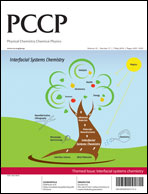We have devised a novel dip coating procedure to form highly crystalline and macroscopic π-conjugated architectures on solid surfaces. We have employed this approach to a technologically relevant system, i.e. the electron-acceptor [6,6]-phenyl C61 butyric acid methyl ester molecule (PCBM), which is the most commonly used electron-acceptor in organic photovoltaics. Highly ordered, hexagonal shaped crystals of PCBM, ranging between 1 to 80 μm in diameter and from 20 to 500 nm in thickness, have been grown by dip coating the substrates into a solution containing the fullerene derivative. These crystals have been found to possess a monocrystalline character, to exhibit a hexagonal symmetry and to display micron sized molecularly flat terraces. The crystals have been prepared on a wide variety of surfaces such as SiOx, silanized SiOx, Au, graphite, amorphous carbon–copper grids and ITO. Their multiscale characterization has been performed by atomic force microscopy (AFM), Kelvin probe force microscopy (KPFM), X-ray diffraction (XRD), optical microscopy, scanning and transmission electron microscopy (SEM, TEM).
To test the stability of these electron accepting PCBM crystals, they have been coated with a complementary, electron donor hexa-peri-hexabenzocoronene (HBC) derivative by solution processing from acetone and chloroform–methanol blends. The HBC self assembles in a well-defined network of nanofibers on the PCBM substrate, and the two materials can be clearly resolved by AFM and KPFM.
Due to its structural precision on the macroscopic scale, the PCBM crystals appear as ideal interface to perform fundamental photophysical studies in electron–acceptor and –donor blends, as well as workbench for unravelling the architecture vs. function relationship in organic solar cells prototypes.
![Graphical abstract: Micron-sized [6,6]-phenyl C61 butyric acid methyl ester crystals grown by dip coating in solvent vapour atmosphere: interfaces for organic photovoltaics](/en/Image/Get?imageInfo.ImageType=GA&imageInfo.ImageIdentifier.ManuscriptID=B923496A&imageInfo.ImageIdentifier.Year=2010)

 Please wait while we load your content...
Please wait while we load your content...